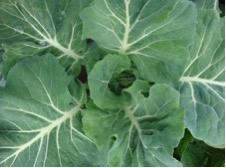Collard
-
Scientific NameBrassica oleracea var. viridis
-
General InformationCollards are a cool season vegetable grown for their leaves. They do not form a head like cabbage.
 Photo: pxhere
Photo: pxhere -
When to Plant
Direct seed or transplant in February and March (through April in cooler areas) and again in September ( maybe June, July, and August in cooler areas). If growing from seed for transplanting, expect six weeks before the starts will be ready to plant.
Germination temperature: 45° F to 85° F. Will germinate at soil temperatures as low as 40° F.
-
Planting
Sow seed one-quarter-inch to a half-inch deep. Space rows 30 inches apart. Thin seedlings to 12 inches apart.
Collards tolerate a wide range of warm to cold temperatures. Leaves are sweeter and more tender in cooler weather.
-
Soil Requirements
Collard greens prefer well-drained soil with a pH of 6.5 to 6.8. Soil borne diseases can be avoided and nematode pest build up can be reduced by crop rotation of Brassicas. Use a floating row cover to protect seedlings from insect pests. Some varieties are bred for resistance (e.g., ‘Cascade Glaze’ resists cabbage worms and loopers), or choose variety characteristics that detract (e.g., waxy leaves may reduce cabbage worm infestation).
-
Water Requirements
Collards need one to one and a half inches of water every week.
-
Fertilizing
Collards need plenty of nitrogen to develop their dark green leaf color. Dig four inches of amended compost into your bed to increase the soil’s nitrogen content, or use an equivalent amount of a high-nitrogen commercial organic garden fertilizer in place of the compost. Follow directions on the package. The plants may need to be side-dressed if they become pale and there is no sign that insects caused the change.
-
Pollination
Collard greens are harvested before they go to flower. If left to go to flower, you will see small, yellow flowers arranged in pyramid-shaped clusters. The flowers attract insects that are responsible for the pollination of this plant.
-
Harvesting
When plants have about 10 leaves, harvest outside leaves to stimulate growth of new leaves. When plants are larger, harvest up to half of the plant leaves at a time. Grow back for about a week before harvesting again. Some prefer to harvest the younger leaves in the inner rosette, while many remove leaves from the bottom up which results in a tree-like stem. Young, smaller leaves are tender and sweet with better texture than the larger, mature leaves. Younger leaves can be eaten raw as wraps or in salads, but the more fibrous leaves are usually chopped, steamed, broiled, sautéed, or slow cooked until they are tender.
-
Storage
After harvest, wash, and store in the refrigerator in the crisper drawer for up to two weeks. Many gardeners leave collards growing in the garden throughout the winter and use it fresh.
Collards may also be blanched, or cooked, and then frozen.
-
Good Varieties for Marin
‘Champion’: 60 to 75 days. Short-stemmed (two feet) with long, broad, wavy leaves. Mild flavor. Waxy blue-green leaves. Bred for frost tolerance, extended harvest, and fast growth.
‘Vates’: 68 days. Slow to bolt. Grows 32 inches tall. Dark, blue-green, long, wavy, wide, tender leaves.
‘Georgia’: 60 to 65 days. Tender, smooth, blue-green leaves. Mild flavor improves with a light frost. Traditional variety in Southern cuisine. Larger than ‘Champion’.
‘Merritt’ collards were developed by Oakland’s Merritt College. It is a cross of ‘Vates’ and ‘Georgia’ along with some kale-relative DNA.
'Cascade Glaze’ resists cabbage worms and loopers.
-
Helpful Tips
Soil borne diseases can be avoided and nematode pest build up can be reduced with crop rotation of your Brassicas. Use a floating row cover to protect seedlings from insect pests.
Plants started in the fall (six to eight weeks before the first frost and harvested throughout temperate winters) produce leaves that are sweeter, less bitter, and more nutrient dense.
-
Common Problems
As with other cruciferous plants, pests include, but are not limited to, cabbage moth, several species of nematodes, and green cabbage loopers.
-
Pests- Diseases & More
Learn more about growing collard greens.

